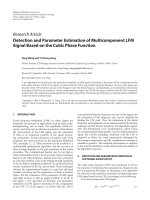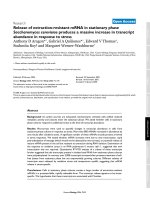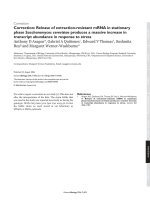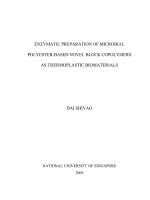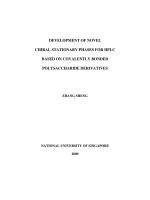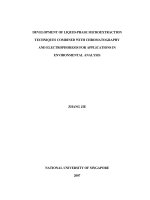Poly(butylene terephthalate) based novel achiral stationary phase investigated under supercritical fluid chromatography conditions
Bạn đang xem bản rút gọn của tài liệu. Xem và tải ngay bản đầy đủ của tài liệu tại đây (1.56 MB, 8 trang )
Journal of Chromatography A, 1549 (2018) 85–92
Contents lists available at ScienceDirect
Journal of Chromatography A
journal homepage: www.elsevier.com/locate/chroma
Poly(butylene terephthalate) based novel achiral stationary phase
investigated under supercritical fluid chromatography conditions
Kanji Nagai, Tohru Shibata ∗ , Satoshi Shinkura, Atsushi Ohnishi
DAICEL Corporation, CPI Company, Life Science Development Center, Innovation Park, 1239, Shinzaike, Aboshi-ku, Himeji, Hyogo, 671-1283, Japan
a r t i c l e
i n f o
Article history:
Received 26 January 2018
Received in revised form 13 March 2018
Accepted 15 March 2018
Available online 17 March 2018
Keywords:
Supercritical fluid chromatography
Stationary phase
Polymer
Ligand
Poly(butylene terephthalate), PBT
Selector
a b s t r a c t
Poly(butylene terephthalate) based novel stationary phase (SP), composed of planar aromatic phenyl
group together with ester group monomer units, was designed for supercritical fluid chromatography
(SFC) use. As expected from its structure, this phase shows planarity recognition of isomeric aromatics
and closely similar compounds. Interestingly, for most analytes, the retention behavior of this SP is significantly distinct from that of the 2-ethylpyridine based SPs which is among the most well-known SFC
dedicated phases. Although the poly(butylene terephthalate) is coated on silica gel, the performance of
the column did not change by using extended range modifiers such as THF, dichloromethane or ethyl
acetate and column robustness was confirmed by cycle durability testing.
© 2018 The Authors. Published by Elsevier B.V. This is an open access article under the CC BY license
( />
1. Introduction
Supercritical fluid chromatography (SFC) is implemented today
as routine technique in many laboratories and arises strong scientific and practical interest [1]. SFC uses pressurized carbon
dioxide (CO2 ) with miscible polar organic solvents (modifier) as
a mobile phase and has become a powerful separation technique
complementary to conventional high performance liquid chromatography (HPLC) and gas chromatography (GC) [2–10]. In the
early developments of the technique, SFC was strongly driven by
the enantioseparation field benefitting from the already existing
chiral stationary phases (CSPs), particularly at preparative scale in
pharmaceutical industry [11–18]. Recently, SFC expanded also in
the achiral separation field, using achiral phases, but even applying
the CSPs as powerful tools in separation of closely related sample
impurities or molecules [19,20].
The mobile phase in SFC has low viscosity and high diffusivity,
which makes it particularly adapted for fast flow analysis. Furthermore, SFC is regarded as an environmentally friendly separation
technique because it uses nontoxic recycled CO2 and the total
amount of organic solvents is smaller than in conventional HPLC.
This high throughput chromatographic performance, as well as
∗ Corresponding author.
E-mail address: tr (T. Shibata).
“green” aspect, make SFC very attractive for numerous applications
[21–31].
The retention and separation characteristics in SFC mainly
depend on a combination between mobile phase and stationary
phase (SP) [6,32–34] The chemical diversity of the currently available SPs has been significantly extended, benefiting from the large
variety of commercially available HPLC SPs (e.g. reverse phase, normal phase, and/or HILIC) that can be also used in SFC mode. Besides
this trend, some column manufacturers and research groups have
originally developed SFC dedicated stationary phases. One wellknown SP designed specifically for achiral SFC separation is the
2-ethylpyridine (2-EP) bonded silica phase. This 2-EP SP offers good
peak shapes, especially for basic compounds, even without any
additives [35].
Other novel achiral SPs dedicated to SFC have been developed
[36–40], however, most of them consisted of a low-molecularweight ligand, coated or covalently attached onto a solid support
(e.g. silica gel). In contrast, only few polymeric type phases have
been described so far for applications in the achiral SFC separation field. Such polymeric phases are expected to interact through
multiple concerted mechanisms with the analytes [40].
Another view point is what kind of major interaction should be
embedded in a SP. While SPs with a variety of interaction types are
needed of course, what are those relatively unmet? The design of
new phases may have to start by defining which are the interaction types needed and combined to make an efficient SP, but also
which interaction mechanisms are relatively unmet in the already
/>0021-9673/© 2018 The Authors. Published by Elsevier B.V. This is an open access article under the CC BY license ( />
86
K. Nagai et al. / J. Chromatogr. A 1549 (2018) 85–92
Fig. 1. Structure of poly(butylene terephthalate) or PBT-based selector of the column DCpak PBT.
existing SPs. In this light, the systematic analysis of interactions
in a variety of commercially available SPs under SFC conditions, as
investigated by West et al., would represent a very suggestive information [41–43]. According to their diagrams, hydrogen-bonding
and van der Waals interactions are more densely covered by already
existing phases, whereas dipolar and aromatic () interactions are
less represented [43].
Based on the above consideration, when looking for innovative
phases, we focused on a polymer with a dipolar group with/without
an aromatic group in or close to its main chain. Among many polymers evaluated, poly(butylene terephthalate), well known as PBT,
was chosen as a novel selector considering its molecular recognition ability and peak efficiency [44]. Its insolubility in most solvents
and remarkable chemical stability were also positive merits supporting the selector choice for column commercial launch (Fig. 1).
In the present study, some features and applications of this SP
under SFC conditions are described.
pressure regulator (ABPR), unless otherwise noted. Lab Solutions
software (V 5.89) was used for system control and data acquisition.
Total flow rate was fixed at 3.0 mL/min, column temperature
was set at 40 ◦ C, and the automated backpressure regulator (ABPR)
was set to 15.0 MPa, unless otherwise noted. Other conditions, such
as modifier, sample concentration, injection volume, and detection
wavelength are described in the figures.
The Thar SFC instrument supplied by Waters Corporation was
used for Section 3.3 dealing with the orthogonal selectivity of the
two columns and Section 3.4 dealing with the modifier effect.
2.3. Data analysis
Relative retention factor (k) was calculated with the equation
below.
k = (V/V 0 ) − 1,
(1)
where V is the elution volume of an analyte and V0 is the
column void volume. V0 was estimated by injecting 1,3,5-tritert-butylbenzene as a non-retained marker conducted as an
independent analysis of each sample injection.
2.4. Dipole moment calculations
Dipole moment calculations were conducted using semiempirical molecular orbital method with PM6 implemented in
SCIGESS software (version 2.3, Fujitsu Ltd., Tokyo, Japan) [45].
2. Experimental
3. Results and discussion
2.1. Chemicals
3.1. Planarity recognition
The modifier used in this study was Japanese Industrial Standard
special grade methanol (MeOH) obtained from Nacalai Tesque Inc.
(Kyoto, Japan). Carbon dioxide of industrial grade (over 99.5%) was
purchased from Tatsumi Industry Co., Ltd. (Hyogo, Japan).
o-Terphenyl, m-terphenyl, p-terphenyl, 3,4-dihydrocoumarin,
coumarin, 6-methylcoumarin, 7-methylcoumarin, dimethyl
phthalate, dimethyl isophthalate, dimethyl terephthalate, triphenylene, cis-stilbene, trans-stilbene, 2-methylbenzophenone,
3-methylbenzophenone,
4-methylbenzophenone,
2hydroxyflavanone, 3 -hydroxyflavanone, 4 -hydroxyflavanone,
phenanthrene,
and
pyrene
were
purtheobromine,
chased
from
Tokyo
Chemical
Industry
Co.
(Tokyo,
Japan). 1,3,5-Tri-tert-butylbenzene, 2-acetylanthracene, 9acetylanthracene, 2-acetylphenanthrene, 3-acetylphenanthrene,
9-acetylphenanthrene, and paraxanthine were purchased from
Sigma-Aldrich Corporation (St. Louis, MO, USA). Naphthacene was
purchased from Nacalai Tesque Inc. 2-Propanol (IPA), chrysene,
estrone, estradiol, estriol, caffeine, theophylline, tetrahydrofuran
(THF), dichloromethane, and ethyl acetate were purchased from
Wako Pure Chemical Industries (Osaka, Japan). n-Hexane (nHex)
was purchased from Kanto Chemical Co. (Tokyo, Japan).
Based on its structural features, the new PBT selector composed
of non-polar aromatic phenyl group together with ester group units
was expected to interact with aromatic compounds. In order to confirm this point, terphenyl isomers (1–3) are investigated, which are
regarded as molecular planarity indicators in HPLC [46,47] and SFC
[48]. Compound 1 deviates from planarity due to the strong steric
repulsion of two phenyl rings located in ortho-position, and this
steric hindrance diminishes for 2 and 3 (in this sequential order).
Fig. 2 shows the SFC chromatograms of 1–3 by using the PBT-based
column (Fig. 2A), compared to the 2-EP SP (Fig. 2B) under isocratic
conditions. The stronger the planarity character of the analyte, the
longer retention was observed on the new column. In contrast,
no resolution between 2 and 3 was achieved on the 2-EP column
(Fig. 2B). This planarity recognition may be attributed to planar and
rigid PBT backbone.
2.2. Instrumentation and chromatographic conditions
DCpak PBT column (initially launched as DCpak SFC-A), sized
150 mm × 4.6 mm (i.d.), was supplied from DAICEL Corporation
(Tokyo, Japan), which is composed of PBT-coated 5 m silica particle. A 2-ethylpyridine (2-EP) column of 5 m particle, sized
150 mm × 4.6 mm (i.d.), was purchased from Waters Corporation
(Milford, MA, USA). The SFC instrument used in this study is NexeraUC supplied by Shimadzu Corporation (Kyoto, Japan) equipped
with a CO2 pump, a modifier pump, a vacuum degasser, a column oven, a multiple wavelength UV detector, and automated back
3.2. Molecular shape recognition
Fig. 3 shows the chromatograms of coumarin (5), its dihydro
form (4), and methyl substituted form (6 and 7). Compound 4 eluted
faster than 5, probably because dihydro 4 has less -electrons than
5, resulting in a weaker interaction between analyte and SP. The
PBT-derived selector can recognize the minor difference of methyl
group position (6 and 7), whereas on the 2-EP column, coumarin 5
and its methyl substituted ones eluted almost at the same time.
Fig. 4A and B shows the SFC chromatograms of three plasticizers, dimethyl phthalate (8), dimethyl isophthalate (9), and dimethyl
terephthalate (10) on both columns. By using the DCpak column,
8 eluted first, followed by 9 and 10 (Fig. 4A). Dipole moment of
8, 9, and 10 is 2.98, 1.60, and 0.01, respectively, which is calculated by using SCIGESS software. Thus, the smaller polarization of
the sample, the longer the retention time tends to be. On the 2EP column, the elution order is totally inverse (i.e. 10 eluted first,
K. Nagai et al. / J. Chromatogr. A 1549 (2018) 85–92
87
Fig. 2. SFC chromatograms of terphenyl isomers on (A) DCpak PBT and (B) 2-EP SPs.
Modifier, MeOH (isocratic conditions, 3%); temperature, 40 ◦ C; ABPR, 15 MPa; flow
rate, 3.0 mL/min; UV detection, 254 nm.
followed by 9 and 8, see Fig. 4B). The relationship between dipole
moments and retention factors by using two columns are displayed
in Supplemental Material (Table S1).
Estron (11), estradiol (12), and estriol (13) are natural estrogenic
hormones, which have almost same skeleton with different number
of hydroxyl groups. Compound 11 has one hydroxyl group, 12 has
two, and 13 has three. Interacting with the PBT selector, polar 13
eluted first, followed by 12 and 11 (Fig. 4C). In contrast, by using
2-EP, less-polar 11 eluted first, then followed by 12 and 13 (Fig. 4D).
This result indicates that DCpak PBT can strongly retain less polar
samples, whereas it will show less retention for more polar samples
(opposite to the 2-EP observations). The results displayed in this
section suggests the high orthogonality of the PBT and the 2-EP
derived SPs.
In order to discuss the characteristic molecular shape recognition behavior of the new column, we then analyzed naphthacene
(14), chrysene (15), and triphenylene (16) under isocratic conditions. These C2 or C3 symmetric polycyclic aromatic hydrocarbons
(PAHs) have the same number of aromatic rings and -electrons
but different molecular shape, which are often used as molecular
shape recognition indicators (Fig. 5). Wise et al. proposed lengthto-breadth (L/B) ratio for describing two dimensional aspect ratio
of such PAHs [49]. The smaller L/B ratio indicates the disk-like
molecule. Indeed, L/B ratio of 14, 15, and 16 is 1.89, 1.72, and 1.12,
respectively. On DCpak PBT, disk-like 16 eluted first, followed by
15, and 14 with a large aspect ratio eluted lastly (Fig. 5A). Contrary
to this, by using 2-EP, 14 with a large aspect ratio eluted first, followed by 15, and 16 eluted lastly (Fig. 5B). The retention factor (k) of
these PAHs on the two columns is summarized in Table S2 in Supplemental Material. Their selectivity trends are orthogonal again. It
is clearly seen that the PBT selector tends to retain the linear PAH
Fig. 3. SFC chromatograms of coumarin derivatives on (A) DCpak PBT and (B) 2-EP
SPs. Modifier, MeOH (isocratic conditions, 2%); temperature, 40 ◦ C; ABPR, 15 MPa;
flow rate, 3.0 mL/min; UV detection, 220 nm.
with large aspect ratio, and 2-EP tends to retain disk-like PAH with
small aspect ratio.
3.3. Orthogonality investigations
As described in previous sections, the separation behavior of
two investigated columns was significantly distinct. Therefore, they
were expected to display complementary selectivity, i.e. orthogonal selectivity. To obtain a deep insight into orthogonality aspects,
we then compared their retention factors measured under isocratic
conditions by using commercially available neutral and slightly
basic 23 samples. These test compounds are classed into seven
different isomeric or closely similar sample families. Fig. 6 shows
the double logarithmic plots of k obtained by two columns. The
detail of samples and retention factors are summarized in Table
S3 in Supplemental Material. As expected, the plots were well dispersed. Indeed, their Pearson’s correlation coefficient (R2 ) was 0.62,
indicating there is not strong correlation between them.
3.4. Modifier effect
Considering that the PBT selector was coated on silica gel, one
may fear “column damage” of selector by using extended solvent
choices, such as THF, dichloromethane (CH2 Cl2 ), or ethyl acetate
(EtOAc). We then examined the stability of retention by using
regioselective acetylated anthracene (17, 18) and phenanthrene
(19–21) as analytes.
88
K. Nagai et al. / J. Chromatogr. A 1549 (2018) 85–92
Fig. 4. (A, B) SFC chromatograms of plasticizers (phthalates) and (C, D) estrogenic hormones on (A, C) DCpak PBT and (B, D) 2-EP SPs. (A, B) Modifier, MeOH (isocratic
conditions, 1%); temperature, 40 ◦ C; ABPR, 15 MPa; flow rate, 3.0 mL/min; UV detection, 230 nm. (C, D) Modifier, MeOH (isocratic conditions, 30%); temperature, 40 ◦ C; ABPR,
15 MPa; flow rate, 3.0 mL/min; UV detection, 210 nm.
Fig. 5. SFC Chromatograms of C2 or C3 symmetric polycyclic aromatic hydrocarbons (PAHs) on (A) DCpak PBT and (B) 2-EP SPs. Modifier, MeOH (isocratic conditions, 25%);
temperature, 40 ◦ C; ABPR, 15 MPa; flow rate, 3.0 mL/min; UV detection, 254 nm.
Fig. 7A shows the SFC chromatogram of five analytes mixture
with 10% of MeOH. Although some peaks were overlapped, these
peaks eluted without heavy peak tailing. After analysis, the mod-
ifier was gradually changed by gradient program. The program
started after 1 min hold with 5% of MeOH, linear gradient ramped
up to 30% of MeOH over 20 min, followed by 39 min hold at 30%
K. Nagai et al. / J. Chromatogr. A 1549 (2018) 85–92
Fig. 6. Double logarithmic plots of retention factor (k) obtained with DCpak PBT
and 2-EP SPs. Filled circles (᭹), 2-methylbenzophenone, 3-methylbenzophenone,
and 4-methylbenzophenone; open circles ( ), cis-stilbene and trans-stilbene;
filled squares (), o-terphenyl, m-terphenyl, p-terphenyl, and triphenylene; filled
triangles ( ), 2-acetylanthracene, 9-acetylanthracene, 2-acetylphenanthrene, 3acetylphenanthrene, and 9-acetylphenanthrene; open diamonds (♦), caffeine, theophylline, theobromine, and paraxanthine; filled diamonds ( ), 2 -hydroxyflavanone,
3 -hydroxyflavanone, and 4 -hydroxyflavanone; open triangles ( ), hydrocortisone
and prednisolone. Modifier, MeOH (isocratic conditions, 5%); temperature, 40 ◦ C;
ABPR, 15 MPa; flow rate, 4.0 mL/min.
89
of MeOH. After the gradient rinsing program was finished, the
same acetylated PAH mixture was injected under isocratic condition (CO2 /MeOH = 90/10). Fig. 7B shows its SFC chromatogram
with 10% of MeOH, and retention time and peak symmetry were
essentially unchanged. Then, the rinsing modifier was changed to
THF/MeOH = 5/1, the same gradient cycle was repeated, and the
same acetylated PAH mixture was evaluated. It should be mentioned that no unidentified peak was observed during this rinsing
process. Fig. 7C shows the SFC chromatogram of the same mixture under 10% of MeOH. Again, unidentified peaks did not appear
during the gradient program, and the chromatogram was almost
same as original one. This gradient rinsing program was repeated by
using CH2 Cl2 /MeOH = 5/1 as modifier, and the same sample mixture
was analyzed, whose chromatogram was almost same (Fig. 7D).
Finally, this procedure was run over by EtOAc/EtOH = 5/1, and the
same sample mixture was analyzed with no change in the resulting
chromatogram (Fig. 7E).
According to these experiments, no sign of degradation was
observed during the gradient process or the chromatographic testing, which suggest that no column damage was observed by passing
through the extended range modifier sequence. The PBT selector
does not dissolve in many organic solvents, which enabled us to
use almost all organic solvents though it was coated on silica gel.
Fig. 7. SFC chromatograms of acetylated anthracene (17, 18) and phenanthrene (19–21) on DCpak PBT SP by passing through various modifiers. Chromatographic conditions
of the tests: Modifier, MeOH (isocratic conditions, 10%); temperature, 40 ◦ C; ABPR, 15 MPa; flow rate, 4 mL/min; UV detection, 254 nm.
90
K. Nagai et al. / J. Chromatogr. A 1549 (2018) 85–92
Fig. 8. (A) Cycle dependent SFC chromatograms and (B) cycle versus retention factors of PAHs on DCpak PBT column. Modifier; MeOH (isocratic conditions, 25%); temperature,
40 ◦ C; ABPR, 15 MPa; total flow rate, 3 mL/min; UV detection, 230 nm; sample concentration, 0.2 mg/mL in nHex/THF = 9/1; injection volume,1 L.
3.5. Cycle durability test
To confirm the cycle durability, three PAHs, phenanthrene (22),
pyrene (23), and triphenylene (16) were used as analytes, under
isocratic conditions. The same experiment was run over 80 cycles.
This test was not performed with the aim of covering method validation parameters, but to confirm the lack of solubility of the coated
selector. Any selector loss under operating conditions would lead
to changes with the applied protocol.
Fig. 8A shows the SFC chromatogram of the first injection of
three PAHs on the column, where the three peaks were well separated. The chromatograms after 20, 40, 60, and 80 cycles are also
shown in Fig. 8A, and the retention time of these samples never
changed until the 80 cycles.
Fig. 8B shows cycle versus their retention factors (k) and confirms the column stability in cycle durability test attributed by the
macromolecular ligand.
4. Conclusions
A novel PBT based stationary phase was designed and confirmed
as versatile tool for SFC use. This SP shows characteristic planarity
recognition of isomeric PAHs and structurally related analytes such
as coumarin derivatives, phthalate plasticizers, and estrogenic hor-
mones. For most compounds, the retention behavior of this SP
was found to be significantly distinct from that of the 2-EP based
SP, which indicate the orthogonal retention relationship between
them. Its stability of the PBT selector towards an extended solvent range and the cycle durability of the column in the operating
conditions were also confirmed.
These results demonstrated that synthetic polymers might be
promising candidates as selectors for achiral separations in SFC
mode. Indeed, this column was used as SFC column screening
for method development in the pharmaceutical industry (see Fig.
10.8 in Ref. [1]). Further investigations dealing with applications
of this new SP in different chromatographic modes are currently
in progress. The design and screening of other synthetic polymer
based ligands are also in the scope of our research team.
Acknowledgments
The authors wish to thank Dr. Pilar Franco and Tong Zhang
in Chiral Technologies Europe S.A.S. for valuable discussions. The
authors also appreciate Dr. Masashi Iwayama in DAICEL Corporation for dipole moment calculations.
This research did not receive any specific grant from funding
agencies in the public, commercial, or not-for-profit sectors.
K. Nagai et al. / J. Chromatogr. A 1549 (2018) 85–92
Appendix A. Supplementary data
Supplementary data associated with this article can be found,
in the online version, at />032.
References
[1] C.F. Poole (Ed.), Supercritical Fluid Chromatography (Handbooks in Separation
Science), Elsevier, 2017.
[2] T.A. Berger, Separation of polar solutes by packed column supercritical fluid
chromatography, J. Chromatogr. A 785 (1997) 3–33, />1016/S0021-9673(97)00849-2.
[3] G. Guiochon, A. Tarafder, Fundamental challenges and opportunities for
preparative supercritical fluid chromatography, J. Chromatogr. A 1218 (2011)
1037–1114, />[4] M. Saito, History of supercritical fluid chromatography: instrumental
development, J. Biosci. Bioeng. 115 (2013) 590–599, />1016/j.jbiosc.2012.12.008.
[5] L.T. Taylor, Supercritical fluid chromatography, Anal. Chem. 82 (2010)
4925–4935, />[6] E. Lesellier, C. West, The many faces of packed column supercritical fluid
chromatography – a critical review, J. Chromatogr. A 1382 (2015) 2–46,
/>[7] V. Desfontaine, D. Guillarme, E. Francotte, L. Nováková, Supercritical fluid
chromatography in pharmaceutical analysis, J. Pharm. Biomed. Anal. 113
(2015) 56–71, />[8] S. Fekete, J.L. Veuthey, D. Guillarme, Comparison of the most recent
chromatographic approaches applied for fast and high resolution separations:
theory and practice, J. Chromatogr. A 1408 (2015) 1–14, />1016/j.chroma.2015.07.014.
[9] A. Tarafder, Metamorphosis of supercritical fluid chromatography to SFC: an
Overview, TrAC Trends Anal. Chem. 81 (2016) 3–10, />1016/j.trac.2016.01.002.
[10] E. Lemasson, S. Bertin, C. West, Use and practice of achiral and chiral
supercritical fluid chromatography in pharmaceutical analysis and
purification, J. Sep. Sci. 39 (2016) 212–233, />201501062.
[11] G. Terfloth, Enantioseparations in super- and subcritical fluid
chromatography, J. Chromatogr. A 906 (2001) 301–307, />1016/S0021-9673(00)00952-3.
[12] G.B. Cox, Enantioselective supercritical fluid chromatography using Daicel’s
platinum series polysaccharide-based columns, in: LC-GC North-America
Appl. Noteb., 2007, 31.
[13] L. Miller, Preparative enantioseparations using supercritical fluid
chromatography, J. Chromatogr. A 1250 (2012) 250–255, />1016/j.chroma.2012.05.025.
[14] P. Franco, T. Zhang, Common screening approaches for efficient analytical
method development in LC and SFC on columns packed with immobilized
polysaccharide-derived chiral stationary phases, in: G.K.E. Scriba (Ed.), Chiral
Sep. Methods Protoc., 2nd ed., Humana Press, Totowa, NJ, 2013, pp. 113–126,
/>[15] J. Lee, J.T. Lee, W.L. Watts, J. Barendt, T.Q. Yan, Y. Huang, F. Riley, M. Hardink, J.
Bradow, P. Franco, On the method development of immobilized
polysaccharide chiral stationary phases in supercritical fluid chromatography
using an extended range of modifiers, J. Chromatogr. A 1374 (2014) 238–246,
/>[16] D.C. Patel, M.F. Wahab, D.W. Armstrong, Z.S. Breitbach, Advances in
high-throughput and high-efficiency chiral liquid chromatographic
separations, J. Chromatogr. A 1467 (2016) 2–18, />chroma.2016.07.040.
[17] S. Khater, M.A. Lozac’h, I. Adam, E. Francotte, C. West, Comparison of liquid
and supercritical fluid chromatography mobile phases for enantioselective
separations on polysaccharide stationary phases, J. Chromatogr. A 1467
(2016) 463–472, />[18] K. Zawatzky, M. Biba, E.L. Regalado, C.J. Welch, MISER chiral supercritical fluid
chromatography for high throughput analysis of enantiopurity, J. Chromatogr.
A 1429 (2016) 374–379, />[19] E.L. Regalado, C.J. Welch, Separation of achiral analytes using supercritical
fluid chromatography with chiral stationary phases, TrAC Trends Anal. Chem.
67 (2015) 74–81, />[20] T. Shibata, S. Shinkura, A. Ohnishi, K. Ueda, Achiral molecular recognition of
aromatic position isomers by polysaccharide-based CSPs in relation to chiral
recognition, Molecules 22 (2017) 38, />molecules22010038.
[21] L.T. Taylor, Packed column supercritical fluid chromatography of hydrophilic
analytes via water-rich modifiers, J. Chromatogr. A 1250 (2012) 196–204,
/>[22] C.Y. Kong, T. Funazukuri, S. Kagei, G. Wang, F. Lu, T. Sako, Applications of the
chromatographic impulse response method in supercritical fluid
chromatography, J. Chromatogr. A 1250 (2012) 141–156, />1016/j.chroma.2012.04.033.
91
[23] J.L. Bernal, M.T. Martín, L. Toribio, Supercritical fluid chromatography in food
analysis, J. Chromatogr. A 1313 (2013) 24–36, />chroma.2013.07.022.
[24] K. Taguchi, E. Fukusaki, T. Bamba, Simultaneous analysis for water- and
fat-soluble vitamins by a novel single chromatography technique unifying
supercritical fluid chromatography and liquid chromatography, J. Chromatogr.
A 1362 (2014) 270–277, />[25] T. Yamada, Y. Nagasawa, K. Taguchi, E. Fukusaki, T. Bamba, 13 – polar lipid
profiling by supercritical fluid chromatography/mass spectrometry method,
in: M.U. Ahmad, X. Xu (Eds.), Polar Lipids, Elsevier, 2015, pp. 439–462, http://
dx.doi.org/10.1016/B978-1-63067-044-3.50017-0.
[26] M. Ishibashi, Y. Izumi, M. Sakai, T. Ando, E. Fukusaki, T. Bamba,
High-throughput simultaneous analysis of pesticides by supercritical fluid
chromatography coupled with high-resolution mass spectrometry, J. Agric.
Food Chem. 63 (2015) 4457–4463, />[27] A. Grand-Guillaume Perrenoud, D. Guillarme, J. Boccard, J.L. Veuthey, D.
Barron, S. Moco, Ultra-high performance supercritical fluid chromatography
coupled with quadrupole-time-of-flight mass spectrometry as a performing
tool for bioactive analysis, J. Chromatogr. A 1450 (2016) 101–111, http://dx.
doi.org/10.1016/j.chroma.2016.04.053.
[28] H. Segawa, Y.T. Iwata, T. Yamamuro, K. Kuwayama, K. Tsujikawa, T. Kanamori,
H. Inoue, Differentiation of ring-substituted regioisomers of amphetamine
and methamphetamine by supercritical fluid chromatography, Drug Test.
Anal. 9 (2017) 389–398, />˛
R. Gieysztor, T. Szymczak, E. Rój, Determination of
[29] K. Ty´skiewicz, A. Debczak,
fat- and water-soluble vitamins by supercritical fluid chromatography: a
review, J. Sep. Sci. 41 (2018) 336–350, />201700598.
[30] G.F. Pirrone, R.M. Mathew, A.A. Makarov, F. Bernardoni, A. Klapars, R.
Hartman, J. Limanto, E.L. Regalado, Supercritical fluid
chromatography-photodiode array detection-electrospray ionization mass
spectrometry as a framework for impurity fate mapping in the development
and manufacture of drug substances, J. Chromatogr. B 1080 (2018) 42–49,
/>[31] C. West, E. Lemasson, S. Bertin, P. Hennig, E. Lesellier, Interest of
achiral-achiral tandem columns for impurity profiling of synthetic drugs with
supercritical fluid chromatography, J. Chromatogr. A 1534 (2018) 161–169,
/>[32] C.F. Poole, Stationary phases for packed-column supercritical fluid
chromatography, J. Chromatogr. A 1250 (2012) 157–171, />1016/j.chroma.2011.12.040.
[33] A. Grand-Guillaume Perrenoud, J.L. Veuthey, D. Guillarme, The use of columns
packed with sub-2 um particles in supercritical fluid chromatography, TrAC
Trends Anal. Chem. 63 (2014) 44–54, />023.
[34] C. Galea, D. Mangelings, Y. Vander Heyden, Characterization and classification
of stationary phases in HPLC and SFC – a review, Anal. Chim. Acta 886 (2015)
1–15, />[35] A. Grand-Guillaume Perrenoud, J. Boccard, J.L. Veuthey, D. Guillarme, Analysis
of basic compounds by supercritical fluid chromatography: attempts to
improve peak shape and maintain mass spectrometry compatibility, J.
Chromatogr. A 1262 (2012) 205–213, />2012.08.091.
[36] R. McClain, M.H. Hyun, Y. Li, C.J. Welch, Design, synthesis and evaluation of
stationary phases for improved achiral supercritical fluid chromatography
separations, J. Chromatogr. A 1302 (2013) 163–173, />1016/j.chroma.2013.06.038.
[37] J. Smuts, E. Wanigasekara, D.W. Armstrong, Comparison of stationary phases
for packed column supercritical fluid chromatography based upon ionic liquid
motifs: a study of cation and anion effects, Anal. Bioanal. Chem. 400 (2011)
435–447, />[38] F.M. Chou, W.T. Wang, G.T. Wei, Using subcritical/supercritical fluid
chromatography to separate acidic, basic, and neutral compounds over an
ionic liquid-functionalized stationary phase, J. Chromatogr. A 1216 (2009)
3594–3599, />[39] M. Dunkle, C. West, A. Pereira, S. Van Der Plas, E. Lesellier, Synthesis of
stationary phases containing pyridine, phenol, aniline and morpholine via
click chemistry and their characterization and evaluation in supercritical fluid
chromatography, Sci. Chromatogr. 6 (2014) 85–103, />4322/sc.2014.023.
[40] C.G.A. da Silva, C.H. Collins, E. Lesellier, C. West, Characterization of stationary
phases based on polysiloxanes thermally immobilized onto silica and
metalized silica using supercritical fluid chromatography with the solvation
parameter model, J. Chromatogr. A 1315 (2013) 176–187, />10.1016/j.chroma.2013.09.055.
[41] C. West, E. Lesellier, Chemometric methods to classify stationary phases for
achiral packed column supercritical fluid chromatography, J. Chemom. 26
(2012) 52–65, />[42] E. Lemasson, S. Bertin, P. Hennig, H. Boiteux, E. Lesellier, C. West, Development
of an achiral supercritical fluid chromatography method with ultraviolet
absorbance and mass spectrometric detection for impurity profiling of drug
candidates. Part I: optimization of mobile phase composition, J. Chromatogr.
A 1408 (2015) 227–235, />[43] C. West, E. Lemasson, S. Bertin, P. Hennig, E. Lesellier, An improved
classification of stationary phases for ultra-high performance supercritical
92
[44]
[45]
[46]
[47]
K. Nagai et al. / J. Chromatogr. A 1549 (2018) 85–92
fluid chromatography, J. Chromatogr. A 1440 (2016) 212–228, .
org/10.1016/j.chroma.2016.02.052.
T. Shibata, S. Shinkura, Stationary phase, WO/2014/017280.
/>scigress/.
K. Kimata, K. Iwaguchi, S. Onishi, K. Jinno, R. Eksteen, K. Hosoya, M. Araki, N.
Tanaka, Chromatographic characterization of silica C18 packing materials.
Correlation between a preparation method and retention behavior of
stationary phase, J. Chromatogr. Sci. 27 (1989) 721–728, />1093/chromsci/27.12.721.
M. Mifune, Y. Mori, M. Onoda, A. Iwado, N. Motohashi, J. Haginaka, Y. Saito,
Separation characteristics of aminopropyl silica gels modified with
copper-phthalocyanine as high performance liquid chromatography
stationary phase, Anal. Sci. 14 (1998) 1127–1131, />analsci.14.1127.
[48] K. Jinno, H. Mae, Molecular planarity recognition of polycyclic aromatic
hydrocarbons in supercritical fluid chromatography, J. High Resolut.
Chromatogr. 13 (1990) 512–515, />[49] S. Wise, W.J. Bonnett, F.R. Guenther, W.E. May, A relationship between
reversed-phase C18 liquid chromatographic retention and the shape of
polycyclic aromatic hydrocarbons, J. Chromatogr. Sci. 19 (1981) 457–465,
/>

